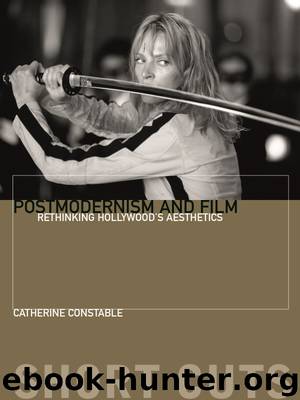Postmodernism and Film by Catherine Constable

Author:Catherine Constable
Language: eng
Format: epub
Tags: PER004030, Performing Arts/Film & Video/History & Criticism, PER004020, Performing Arts/Film & Video/Guides & Reviews
Publisher: Columbia University Press
Published: 2015-06-08T16:00:00+00:00
Popularising Jameson
Booker explicitly presents his work as a popularisation and simplification of Jameson’s position (2007: xviii). The postmodern is defined as ‘the “cultural logic” of late capitalism, directly expressing its characteristics in aesthetic form’ (ibid.; emphasis added). The quotation fuses the economic and the aesthetic, straightforwardly collapsing the relations between base and superstructure, and thereby taking Jameson’s argument to its logical conclusion. The two major aesthetic features of postmodern film are pastiche and fragmentation. Booker shifts aspects of Jameson’s analysis of postmodern aesthetics, attributing key characteristics, such as the waning of affect, to the condition of late capitalism. He follows Jameson in presenting contemporary global capitalism as increasingly all-pervasive, defining postmodernism as ‘the cumulative effect of a number of continuous historical processes associated with the gradual globalisation of capital and the increasing penetration of consumerist practices into every aspect of daily life’ (2007: 50). Thus, like Jameson, he wrestles with the issue of spaces outside capitalism in which to locate the possibility of critique as well as the major issue of what is to constitute proper critique.
Booker reworks Jameson’s distinction between van Gogh’s A Pair of Boots and Warhol’s Diamond Dust Shoes, offering a film-based comparison between Frederico Fellini’s 8½ (1963) and Tim Burton’s Edward Scissorhands (1990). However, unlike van Gogh’s painting, Booker does not position Fellini’s film as emblematic of high modernism, instead placing 8½ on the cusp between modernism and the postmodern (2007: 33, 138). The two contrasting films are used to demonstrate the waning of affect within the postmodern. The semi-autobiographical nature of Fellini’s film is said to enable the viewer ‘to feel a heart behind’ the images (2007: 32). The sense of emotional substance, initially provided by the director, is then shifted to the film’s main protagonist: ‘Fellini’s Anselmi may be unable to love, but he seems to feel genuine emotions (and is a genuinely tormented human artist)’ (2007: 33). In contrast to Anselmi, Burton’s titular protagonist Edward Scissorhands ‘is almost entirely lacking in emotional depth, is all surface’ (ibid.). Thus the waning of affect, here understood as a loss of ‘genuine’ emotion, is intrinsically linked to the process of becoming surface. For Booker, the tortured depths displayed by Fellini’s protagonist conform to the distinctive cultural pathology of modernism: ‘Anselmi’s predicament … is alienation’ (ibid.). In contrast, the sheer superficiality of Johnny Depp’s performance as Edward Scissorhands means that alienation is no longer a possibility.
For Booker, Depp’s role as Willy Wonka in Burton’s Charlie and the Chocolate Factory (2005) equals the superficiality of his performance in Edward Scissorhands (2007: 33, xiii). In a departure from Roald Dahl’s book from 1964, Charlie and the Chocolate Factory briefly charts Wonka’s relationship with his father – a controlling, chocolate-hating, dentist. Booker argues that this childhood trauma is not evident in Depp’s performance of the adult Wonka; there are no lapses suggesting unconscious depths. Instead, Wonka’s overtly eccentric mannerisms foreground his oddness, reducing him to his economic role: ‘all surface and no depth, his entire life consisting of his economic function as a designer and producer of sweets’ (2007: xiii).
Download
This site does not store any files on its server. We only index and link to content provided by other sites. Please contact the content providers to delete copyright contents if any and email us, we'll remove relevant links or contents immediately.
Call Me by Your Name by André Aciman(20350)
Ready Player One by Cline Ernest(14494)
How to Be a Bawse: A Guide to Conquering Life by Lilly Singh(7360)
Wiseguy by Nicholas Pileggi(5648)
The Kite Runner by Khaled Hosseini(5061)
On Writing A Memoir of the Craft by Stephen King(4847)
Audition by Ryu Murakami(4822)
The Crown by Robert Lacey(4710)
Call me by your name by Andre Aciman(4599)
Gerald's Game by Stephen King(4556)
Harry Potter and the Cursed Child: The Journey by Harry Potter Theatrical Productions(4427)
Dialogue by Robert McKee(4305)
The Perils of Being Moderately Famous by Soha Ali Khan(4156)
Dynamic Alignment Through Imagery by Eric Franklin(4099)
Apollo 8 by Jeffrey Kluger(3621)
Seriously... I'm Kidding by Ellen DeGeneres(3564)
The Inner Game of Tennis by W. Timothy Gallwey(3557)
How to be Champion: My Autobiography by Sarah Millican(3544)
Darker by E L James(3463)
